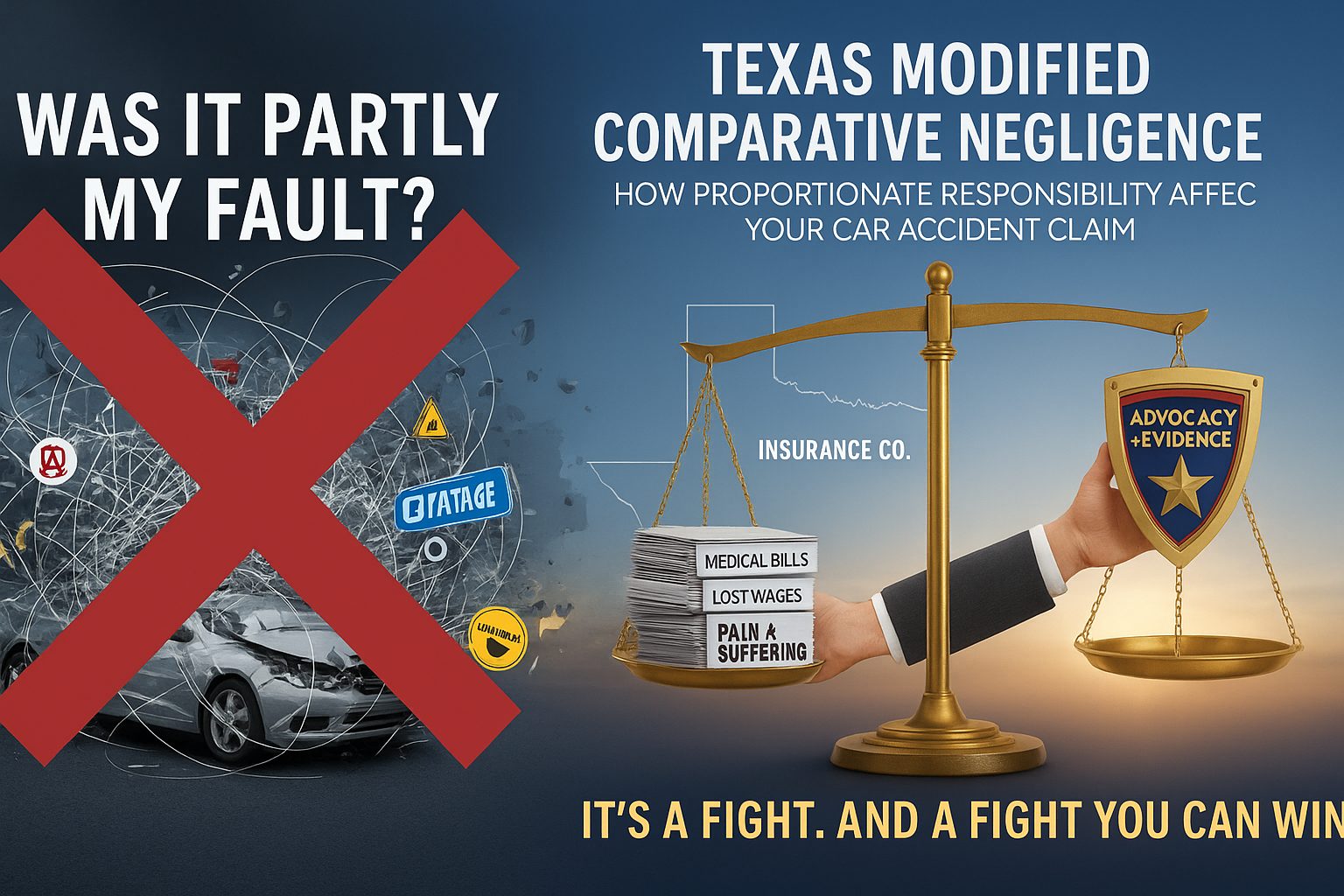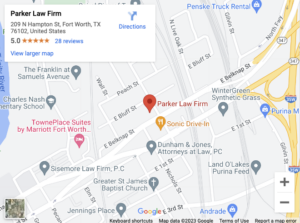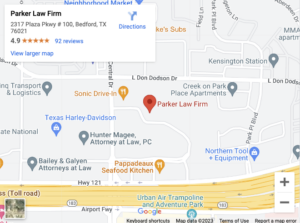Texas Modified Comparative Negligence: How Proportionate Responsibility Affects Your Car Accident Claim

After a car accident, many people wonder if they’re partly at fault. This concern can feel overwhelming, making you think you have no right to seek compensation. In Texas, however, your share of responsibility isn’t fixed. It’s something you can and should challenge.
In the confusion after a crash, insurance companies may try to assign you greater blame to minimize payouts. But their version isn’t final. Understanding Texas law and working with an advocate can help you challenge their narrative and regain control of your claim.
What is Modified Comparative Negligence in Texas?
When you’ve been injured because of someone else’s carelessness, the legal system has to figure out how to assign responsibility. In Texas, we don’t use an all-or-nothing system. Instead, the law recognizes that life is rarely black and white. More often than not, multiple factors and sometimes multiple people contribute to an accident. This is where the legal concept of Texas modified comparative negligence comes into play. It’s a framework designed to distribute fault in a way that is fair and just, allowing injured individuals to recover compensation even if they are found to be partially responsible for the incident.
Definition of modified comparative negligence
At its core, modified comparative negligence is a legal doctrine that compares the fault of everyone involved in an accident and assigns a percentage of blame to each person. Think of it as a pie chart of responsibility. After a collision, a judge, jury, or insurance adjuster will examine all the evidence to determine how much each driver’s actions contributed to the crash. One driver might be found 70% at fault for running a red light, while the other driver might be found 30% at fault for speeding slightly at the time of the impact. This system ensures that a person primarily responsible for causing harm is held accountable, while also acknowledging any actions contributed by the injured party. It’s a balanced approach that aims for fairness rather than a simple declaration of guilt or innocence.
The Texas 50% bar rule explained
While Texas law allows for shared fault—meaning more than one party can be held responsible for an accident, it also draws a very clear and unforgiving line in the sand. This is known as the Texas 50% bar rule, which states that you can only recover financial damages if your percentage of fault is determined to be 50% or less. In legal terms, this means that if you are found to be 51% or more at fault, you are prohibited by law from receiving any compensation. This creates what is called a “cliff-edge” consequence: the difference between being 50% at fault and 51% at fault is not just one percentage point; it is the difference between recovering damages for your injuries and walking away with nothing. Often, this single percentage point is where your entire case will be won or lost.
Contributory negligence vs modified comparative negligence
To fully appreciate the Texas system, it helps to understand what it is not. A handful of states still operate under an old, much harsher doctrine called contributory negligence. In those states, if you are found to be even 1% at fault for your own injuries, you are completely barred from recovering any damages. If a driver runs a stop sign and hits you, but you were going one mile per hour over the speed limit, a contributory negligence system could say you get nothing. Texas, thankfully, moved away from this unforgiving standard. Our modified comparative negligence system, also known as the Texas proportionate responsibility law, was designed to create more equitable outcomes. It acknowledges that minor missteps shouldn’t prevent catastrophically injured people from getting the help they need. This framework gives you a fighting chance, but it also makes the fight over every single percentage point more important than ever.
How Fault is Allocated Under Texas’s Proportionate Responsibility
Determining fault percentages follows Texas’s proportionate responsibility statutes. This is a careful process involving the presentation and weighing of evidence. For anyone injured, understanding this allocation is the first step to protecting your rights and pursuing just compensation. With proper guidance, the process becomes manageable.
Proportionate responsibility basics
Under the Texas proportionate responsibility framework, a jury or insurance adjuster must determine the fault of each party involved in an incident. This includes not only drivers in a car crash but also passengers, pedestrians, or companies responsible for road maintenance or vehicle manufacturing. Each party’s actions are reviewed to assess whether they failed to exercise reasonable care. Fault is assigned so that the total equals 100%, and it is divided among all responsible parties. Chapter 33 of the Texas Civil Practice and Remedies Code sets out this system for handling shared fault cases in our state.
Multi-party and shared fault scenarios
Accidents are often more complex than simple collisions. In chain-reaction crashes involving multiple vehicles, determining proportionate responsibility is crucial. Fault may be distributed among drivers; for example, the driver who caused the initial impact could be assigned 60% of the blame, a second driver who was following too closely 20%, and a third who failed to brake in time the remaining 20%. Each person’s recovery is based on their fault percentage. A thorough investigation is essential to prevent unfair blame and ensure justice.
Examples of fault percentages among parties
To clarify, consider this example: A driver makes an illegal left turn and collides with a motorcyclist. Although the driver is negligent, evidence may show the motorcyclist was speeding by 15 mph. After reviewing the facts, a jury may find the car driver 80% at fault and the motorcyclist 20% at fault. The motorcyclist can still recover damages, but the award is reduced by their 20% share of blame. This division of responsibility is central to comparative fault in Texas law.
Impact on Damages and Insurance When You’re Partially at Fault
Once fault percentages are set, they directly affect your case’s financial result. Being partially at fault affects not only your ability to recover but also how much you recover. This calculation connects the legal theory to real financial outcomes.
Damages calculation with fault percentages
Damage calculations in Texas have significant consequences. For instance, if a motorcyclist is found 20% at fault and the jury values their damages at $500,000, that amount is reduced by their share of fault—$100,000. Thus, the motorcyclist can recover $400,000 from the at-fault driver’s insurance. This is the essence of comparative negligence in Texas: you are compensated for harm by others, but not for the portion attributed to your own actions.
Impact of UM/UIM coverage on fault determinations
The concept of shared fault also extends to claims made under your own insurance policy, specifically Uninsured/Underinsured Motorist (UM/UIM) coverage. Many people mistakenly believe that because they are filing a claim with their own insurance company, fault is no longer an issue. This is incorrect. When you make a UIM claim, your insurance company effectively steps into the shoes of the at-fault driver. They have the right to assert the same defenses, including arguing that you were partially to blame for the accident. Therefore, the Texas50% bar rule and the principles of proportionate responsibility apply just as strongly. Your own insurer can, and often will, attempt to assign you a percentage of fault to reduce or deny your claim, making skilled legal advocacy just as important in these cases.
Economic vs non-economic damages under proportionate fault
When we talk about damages, we are referring to both economic and non-economic losses. Economic damages are the tangible, calculable costs associated with your injury, such as hospital bills, rehabilitation costs, and lost income from being unable to work. Non-economic damages are intangible harms, such as physical pain, emotional distress, and loss of enjoyment of life. Under Texas law, your assigned percentage of fault reduces the total amount of both types of damages. If you are found 30% at fault, your recovery for medical bills will be reduced by 30%, and your recovery for pain and suffering will also be reduced by 30%. This comprehensive reduction highlights the high stakes involved in the fight over fault.
Common Questions and Clarifications (People Also Ask)
Navigating the aftermath of an accident is confusing, and it’s natural to have questions. Many of our clients come to us with similar concerns, worried about how their own actions might affect their ability to get help. They have heard bits and pieces about the law and are often filled with more anxiety than answers. Let’s break down some of the most common questions we hear, because clearing up this confusion is the first step toward empowering you to make the best decisions for your future. You don’t have to face this alone, and you deserve clear, honest answers.
What is the 51% bar rule in Texas?
Clients often ask us, “What is the 51% bar rule in Texas?” and it’s a critically important question. This rule is the absolute cutoff point for recovery. To be precise, under the Texas proportionate responsibility law, if you are found to be 51% or more responsible for the incident that caused your injuries, you are legally barred from recovering any money from the other at-fault parties. This isn’t a negotiation; it’s a strict legal barrier. It’s the reason why insurance companies will fight so hard to push your share of the blame over that 50% threshold. They know that if they can convince a jury that you are just one percentage point over the line, their obligation to pay for your damages disappears entirely.
Can I recover if I’m partially at fault (e.g., 40% at fault)?
This is perhaps the most hopeful question we answer. Many people assume any fault on their part means they have no case. So, can you recover if you’re partially at fault, for example, 40% at fault? The answer is a definitive yes. As long as your percentage of fault is 50% or less, you are entitled to seek compensation under the law of modified comparative negligence in Texas. If your damages are calculated at $100,000 and you are found 40% at fault, you can still recover $60,000. This is the core principle that gives injured people a path to justice even when an accident isn’t entirely one-sided. Never let an insurance adjuster convince you that, because you might share some blame, your claim is worthless.
How does fault distribution affect multi-car accidents?
Multi-car accidents create a complex web of liability, and clients rightfully wonder how fault is distributed in these chaotic situations. In a multi-car pileup, a jury will look at the actions of every single driver involved and assign a percentage of fault to each one. For example, in a three-car crash, Driver A might be 70% at fault, Driver B 30%, and Driver C 0%. Driver C, being blameless, could then pursue a claim against both Driver A and Driver B to recover their damages. The process is intricate and requires a deep dive into the evidence to untangle the sequence of events and the negligence of each party involved in the Texas car accident fault determination.
How to prove fault under Texas proportionate responsibility?
Understanding the rule is one thing; proving it is another. The question of how to prove fault under Texas proportionate responsibility is where legal strategy becomes paramount. Fault is not determined by opinions or assumptions; it is established with hard evidence. This includes police reports, witness statements, accident reconstruction analysis from engineering experts, vehicle “black box” data, surveillance or dashcam footage, and photographs of the scene. The entire case hinges on gathering, preserving, and presenting this evidence in a compelling way that clearly demonstrates the other party’s negligence while minimizing your own assigned percentage of fault. This is the battlefield where experience and relentless preparation make all the difference.
Does shared fault affect settlement timelines?
Finally, people want to know if these disputes over fault will drag out their case. The answer is that shared fault can certainly affect settlement timelines. Because the percentage of fault is so directly tied to the financial outcome, it is often the most heavily disputed issue in a personal injury claim. Insurance companies will use any evidence they can to increase your share of the blame, and these negotiations can take time. An experienced attorney knows how to counter these tactics and push back against unreasonable delays, but it’s important to understand that fighting for a fair allocation of fault is a marathon, not a sprint. Rushing to a quick settlement often means accepting an unfair percentage of blame and leaving money on the table.
Examples, Case Studies, and Practical Guidance
The principles of proportionate responsibility can seem abstract until you see how they play out in real-world situations. At our firm, we’ve seen firsthand how a meticulous, evidence-driven approach can completely change the outcome of a case, turning a potential denial into a significant recovery for our clients. We don’t just explain the law; we use it as a tool to fight for the justice our clients deserve. This is about more than theory it’s about results.
Simple fault split example (e.g., 30% vs 70%)
Consider a common intersection accident. A driver is waiting to make a left turn at a green light without a protected arrow. They misjudge the speed of an oncoming car and turn into its path, causing a collision. The driver of the oncoming car was texting and didn’t hit the brakes as quickly as possible. In this case, a jury might determine that the driver who made the unsafe left turn is 70% at fault, while the distracted driver is 30% at fault. Both drivers were negligent, but the law assigns a greater share of the responsibility to the driver whose actions were the primary cause of the crash.
Multi-car fault allocation example
Now, let’s look at a more complex multi-car scenario on the highway. A truck driver, fatigued from driving too many hours, drifts into the next lane and sideswipes a car. That car then spins out and is hit by a third vehicle that was following too closely to stop in time. The truck driver might be found 60% at fault for the initial illegal lane change. The driver of the third vehicle could be assigned 40% fault for following too closely and failing to maintain a safe distance. The driver of the sideswiped car, who was simply in the wrong place at the wrong time, would be found 0% at fault and could seek compensation from the other two drivers.
Evidence needed to prove fault and its impact on the settlement
This is where our firm’s approach makes a tangible difference. Insurance companies are experts at using the Texas 51% bar rule as a weapon. They will seize upon any admission of fault, any gap in the evidence, to shift blame and deny justice. We encountered this exact tactic in a recent multi-vehicle collision case. Our client was initially told by the insurance adjuster that, based on the preliminary police report, they were likely 55% at fault, which would mean they would receive nothing. The client felt defeated, ready to give up.
But we knew that the initial assignment of fault is just the opening move in a long chess match. Our team immediately launched an exhaustive investigation. We canvassed the area for witnesses the police had missed and found two independent individuals who saw the entire event unfold. We secured crucial dashcam footage from another vehicle that directly contradicted the insurer’s narrative. We presented this new, undeniable evidence, demonstrating that the other driver’s reckless behavior was the true cause of the crash. The insurance company’s position crumbled. We turned their initial projection of 55% fault into a final determination of 40% fault for our client, resulting in a significant settlement that provided for their medical care and future needs. This is the proof that your percentage of fault is not a fact; it’s a fight. And it’s a fight that is won with evidence.
How to Protect Your Claim: Next Steps
If you have been injured in an accident, the steps you take in the hours, days, and weeks that follow can have a massive impact on your ability to secure a fair recovery. Knowing how to protect yourself and your claim is the first step in taking back control. It’s about being proactive and strategic from the very beginning, ensuring that you are building the strongest possible foundation for your case.
Immediate steps after a crash
In the immediate aftermath of a crash, your first priority is always your health and safety. Seek medical attention right away, even if you don’t feel seriously injured. Some injuries, like traumatic brain injuries or internal damage, may not have immediate symptoms. Call the police to the scene so that an official report can be created. Use your phone to take pictures and videos of the vehicles, the surrounding area, and any visible injuries. If there are witnesses, get their names and contact information. And crucially, do not apologize or admit fault to anyone, not the other driver, not the police, and especially not an insurance adjuster. Any statement you make can be twisted and used against you in the fight over fault.
How to choose a Texas board-certified personal injury attorney
When your future is on the line, you need more than just any attorney; you need a specialist. Choosing a Texas board-certified personal injury attorney means you are selecting a lawyer who has been recognized by the Texas Board of Legal Specialization for their extensive experience, rigorous testing, and proven expertise in this specific area of law. Look for a firm that treats you like family, not like a case number on an assembly line. You want an advocate who will give your case the individualized attention it deserves, someone who has a track record of fighting giants in court and winning. An attorney who is transparent about their process and operates on a “no fee unless we win” basis shows that they are confident in their ability and invested in your success.
Key documents to collect and how to preserve evidence
From the very beginning, you should act as the primary guardian of the evidence in your case. Start a file and collect every document related to the accident. This includes the police report, the information exchanged with the other driver, medical records, and bills from every doctor and hospital visit, and receipts for any out-of-pocket expenses. Keep a journal detailing your physical pain, your emotional state, and how your injuries are impacting your daily life. If your car has a “black box” or data recorder, make sure that information is preserved before the vehicle is repaired or salvaged. Every piece of paper, every photograph, and every memory is a potential piece of the puzzle that will help your attorney fight tirelessly for you.
Your life can change in the blink of an eye, and the weight of a serious injury can feel overwhelming. When you’re also grappling with the fear that you might be partly to blame, it’s easy to feel like you have nowhere to turn. But you are not alone in this. The complexities of Texas modified comparative negligence are not something you should have to navigate by yourself, especially when you are trying to heal.
At Parker Law Firm, we have dedicated our careers to standing up for people just like you. We understand that the battle over a single percentage point can determine your entire future. We know the tactics insurance companies use to manipulate fault, and we know how to fight back with facts, evidence, and relentless advocacy. We treat our clients like family, because we believe everyone deserves a champion in their corner.
If you have been injured and are worried about shared fault, don’t let that fear stop you from seeking the justice you deserve. Your percentage of fault is not what an insurance adjuster says it is. It’s a number that has to be proven, and we are here to fight that battle for you. Contact us today for a free, confidential consultation. Let’s talk about what happened. Let us be the attorneys you want, right when you need us the most.


